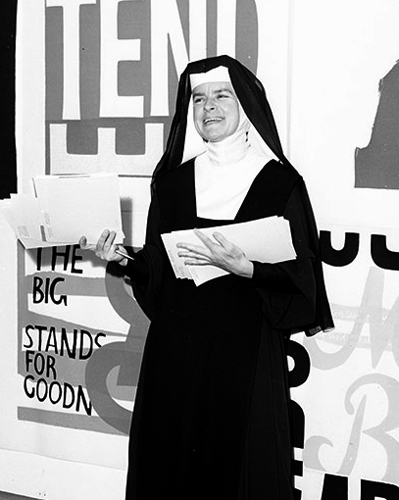 |
Corita Kent | |
| Birth Date: November 20, 1918 |
||
| Death Date: September 18, 1986 Artist Gallery |
||
| Known for her bold, engaging combinations of text and images, Corita Kent was a groundbreaking figure in the art world of the 1960s. Born Frances Elizabeth Kent in Iowa, the fifth of six children, Kent grew up in Hollywood after her family moved there when she was 5.
Coming from a staunchly religious Catholic background, Kent joined the Order of the Immaculate Heart of Mary in 1936 after high school and selected the name “Mary Corita” when she took her vows. There, in their convent in Los Angeles, her artistic talent was recognized by one of the senior nuns, Sister Magdalene Mary, who encouraged Kent to train as an art teacher. From 1947 to 1968, Kent taught classes in the art department at Immaculate Heart College in Los Angeles, a liberal arts institution well known for its avant-garde views, where she encouraged a highly collaborative artistic environment. A vibrant yet demanding teacher, she prompted her students to engage with the world beyond the classroom both artistically and socially. She became head of Immaculate Heart College’s art department in 1964.
Kent began screenprinting in the 1950s, creating dense, expressionist work based on Biblical passages. By the 1960s, Kent had embraced L.A.’s chaotic cityscape as a source of inspiration and was incorporating text from its signage and advertisements into her work. She often appropriated advertising slogans, juxtaposing them with poetry, scripture, and song lyrics, transforming the mundane into messages of hope and calls to action. Her serigraphs speak in the language of Pop art, with words and images borrowed from everyday sources. She often commented on the social issues that defined this tumultuous period, including the Vietnam War and racial injustice, through her work.
Los Angeles in the 60s was an exciting place at a momentous time: Kent’s work brought contact with figures such as filmmaker Alfred Hitchcock, composer John Cage, architect Buckminster Fuller, and designers Charles and Ray Eames, who became her close friends and champions. Her work became more prominent, and in the winter of 1967 she was featured on the cover of “Newsweek” with the headline reading: “The Nun: Going Modern.” But the Archbishop of Los Angeles, Cardinal James McIntyre, was a diehard traditionalist who strongly disapproved of the views of the nuns of Kent’s order, and particularly of the art of Kent herself.
In 1968, exhausted from her teaching schedule and increasingly public profile, Kent took a sabbatical to Cape Cod, Massachusetts. When her sabbatical concluded, Kent decided not to go back to the convent to dedicate more time to herself and her work, moving into an apartment in Boston. In 1978, Kent received a commission from the Boston Gas Company for one of its gas tanks. Her design became the largest copyrighted artwork in the world.
In 1974, Kent was diagnosed with cancer, and her work underwent another decisive change as she turned to a more universal message of peace, love, and hope. Her work became quieter, nature-inspired, and reflective of her diagnosis with cancer and search for meaning from other religious traditions. In 1983, Kent created her “we can create life without war” billboards for the Physicians for Social Responsibility, and in 1983 is asked to design a postage stamp.
Kent ultimately lost her battle with cancer in 1986. She lives on as a Pop art icon like Andy Warhol and Robert Rauschenberg, and an advocate for social justice. Her dynamic images and their messages continue to resonate with contemporary viewers. She once said, “I am not brave enough to not pay my income tax and risk going to jail. But I can say rather freely what I want to say with my art.” |
||


